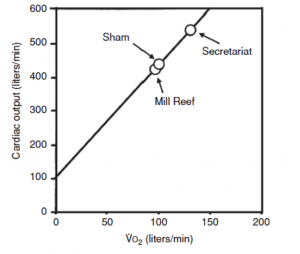Posts Tagged ‘california chrome’
California Chrome Goes For It
Last year prior to the Belmont Stakes I did a post on the great race horse Secretariat who won the Triple Crown in 1973 with the most impressive athletic performance I have ever seen or heard of. This weekend if California Chrome can win the Belmont Stakes, he will be the first horse since 1978 to win the Triple Crown.
Humans vs. Horses
Horses in general and thoroughbred horses in specific are remarkable running machines. Secretariat covered 1.5 miles (about 2413 meters) in the Belmont in 2 minutes and 24 seconds and won by about 30 lengths. When I use a race conversion calculator to estimate how fast a human could run 1.5 miles, here is what I come up with using current world records for men from 800 to 5000 meters and rounding to the second.
Distance Time Estimate for 1.5 miles
800 m 1:40.91 5:25
1000 m 2:11.96 5:35
1500 m 3:26.00 5:41
Mile 3:43.13 5:42
2000 m 4:44.79 5:47
3000 m 7:20.67 5:50
5000 m 12:37.35 5:49
The average of the above estimates is 5:41 meaning that Secretariat covered the distance about 2.4 times as fast as a world class human middle distance runner might.
Maximal Oxygen Uptake
For both humans and horses running really fast for a few minutes requires a high maximal oxygen uptake. This means that the heart has to be able to pump a large amount of blood to the muscles where the oxygen is used to help power the running. The lungs then have to be able to transfer oxygen to the blood as it returns from the muscles. In elite human middle distance runners of 60-70 kgs, the heart can pump somewhere between 30 and 40 liters every minute, and it is not unusual to see such athletes breathing 150 to 200 liters per minute. In these athletes maximal oxygen uptake can be about 80 ml/kg/minute or between about 4.5 and 6 liters per minute when you don’t divide by body weight.
What About Horses?
My colleague David Poole at Kansas State University has done some incredible studies of exercise capacity in race horses. The graph below is from a terrific scientific review article he did with his colleague Howard Erickson on oxygen transport in horses and dogs. The graph shows the estimated cardiac output and oxygen uptake (VO2) in some notable horses. These horses weigh about 500kg so they are about seven or eight times bigger than elite human runners. When you take the numbers off the graph Secretariat had an estimated oxygen uptake of about 130 liters per minute! This value is about 20 times greater than that seen in an elite human runner and means that on a body weight basis it was something like 260 ml/kg/minute — or more than three times the values seen in elite humans. It is also one of the major explanations of why he could run 2.4 times faster than a human. His estimated cardiac output was about 550 liters per minute. For those of you who think in terms of gallons that is almost 150 gallons per minute! Breathing volumes in the range of 2-3000 liters per minute are also possible in these great animals.
When You Watch
When you watch the race this Saturday the horses will be running about 50% faster than Usain Bolt and 24 times as far. The corporate sponsors of the race aside, the race is really being brought to you by Mother Nature, selective breeding and the physiology of oxygen consumption all working together at the outer limits of biology.


